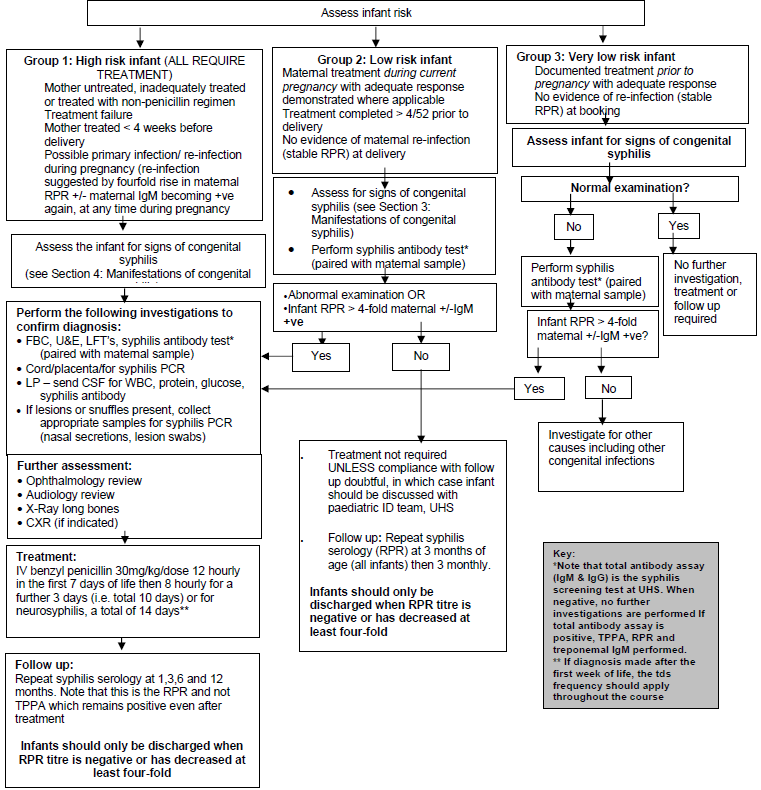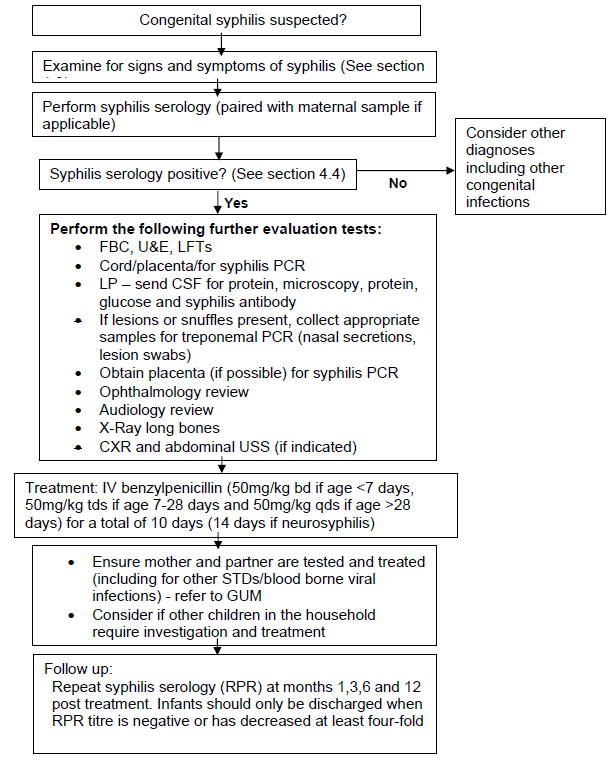- Home
- Guidelines
- Innovation
-
Education
- Study Days & Courses
- STAR Simulation App
- Faculty Resources
- Videos >
- Respiratory Videos (High flow, Tracheostomies, Chest drains, and sleep studies)
- Speciality Training Resources
- Paediatric Long Term Ventilation Team
- Life Support Resources
- #PedsCards Against Humanity
- Bronchiolitis Surge Resources
- Other Educational Opportunities
- Research
- Conference
-
Trainees
- Preceptorships
-
Networks
- Wessex Children's and Young Adults' Palliative Care Network
- PREMIER - Paediatric Regional Emergency Medicine Innovation, Education & Research Network
- Wessex Allergy Network
- Wessex Paediatric Endocrine Network
- Wessex Diabetes Network
- Clinical Ethics >
- TV and Wessex Neonatal ODN
- Regional Referrals to Specialist Services >
- Search
Congenital Syphilis
|
|
Executive Summary
There has been an increase in the diagnosis of syphilis in England since 1997. Syphilis control in pregnant women through universal screening and treatment of positive cases is important and has been established as a feasible and cost-effective intervention. Near elimination of congenital syphilis has been achieved. In a UK study, the total number of identified cases per year in the UK were 10 (2010), 2 (2011 – 2013, and 1 (2014), giving a calculated incidence of 0.0025/1000 births (2011 & 2012), and 0.0026/1000 births (2013), and 0.0013/1000births (2014), all below the World Health Organisation target of 0.5/1000 births (1). This milestone has been possible due to relatively simple interventions focused on maternal and newborn care.
The guideline is applicable for people involved in the care of babies born to mothers diagnosed with syphilis as well as people involved in the care of children potentially infected congenitally with syphilis. It provides overview information on congenital syphilis and on the identification, investigation, treatment and follow-up of exposed and infected infants.
It has been developed in agreement with members of the neonatal, virology and paediatric infectious disease (PID) teams of University Hospital Southampton (UHS) NHS Trust, the Wessex Paediatric Infectious Diseases Network and is in line with the Centre for Communicable Diseases Control and Prevention (CDC) congenital syphilis treatment guidelines 2015, Public Health
England (PHE) syphilis diagnostic guideline (2) and the British Association for Sexual Health and HIV (BASHH) UK national guidelines for the management of syphilis 2015 (3).
Scope
This is general guidance to assist prescribers. We advise prescribers to evaluate each case carefully. Pharmacy and the treating clinical team should be consulted in anticipation of administration difficulties or if any questions or concerns about this guidance.
Where possible, antiepileptic drugs should be given before and after surgery, in consultation with the anaesthetic team. Sometimes it may be possible to administer the pre-surgical dose but not the post-operative doses. Agreement may need to be sought between an anaesthetist and a surgeon. The PEJ route may need to be considered.
Please note this is not an exhaustive list e.g. – Zonisamide, Brivaracetam, Stiripentol. Your local pharmacy team and the paediatric neurology team at University Hospital can be
contacted in such cases.
Purpose
To optimise giving of anti-convulsant medications, and thus seizure control, when usual route/drug not possible due to surgery or illness.
Definitions
There has been an increase in the diagnosis of syphilis in England since 1997. Syphilis control in pregnant women through universal screening and treatment of positive cases is important and has been established as a feasible and cost-effective intervention. Near elimination of congenital syphilis has been achieved. In a UK study, the total number of identified cases per year in the UK were 10 (2010), 2 (2011 – 2013, and 1 (2014), giving a calculated incidence of 0.0025/1000 births (2011 & 2012), and 0.0026/1000 births (2013), and 0.0013/1000births (2014), all below the World Health Organisation target of 0.5/1000 births (1). This milestone has been possible due to relatively simple interventions focused on maternal and newborn care.
The guideline is applicable for people involved in the care of babies born to mothers diagnosed with syphilis as well as people involved in the care of children potentially infected congenitally with syphilis. It provides overview information on congenital syphilis and on the identification, investigation, treatment and follow-up of exposed and infected infants.
It has been developed in agreement with members of the neonatal, virology and paediatric infectious disease (PID) teams of University Hospital Southampton (UHS) NHS Trust, the Wessex Paediatric Infectious Diseases Network and is in line with the Centre for Communicable Diseases Control and Prevention (CDC) congenital syphilis treatment guidelines 2015, Public Health
England (PHE) syphilis diagnostic guideline (2) and the British Association for Sexual Health and HIV (BASHH) UK national guidelines for the management of syphilis 2015 (3).
Scope
This is general guidance to assist prescribers. We advise prescribers to evaluate each case carefully. Pharmacy and the treating clinical team should be consulted in anticipation of administration difficulties or if any questions or concerns about this guidance.
Where possible, antiepileptic drugs should be given before and after surgery, in consultation with the anaesthetic team. Sometimes it may be possible to administer the pre-surgical dose but not the post-operative doses. Agreement may need to be sought between an anaesthetist and a surgeon. The PEJ route may need to be considered.
Please note this is not an exhaustive list e.g. – Zonisamide, Brivaracetam, Stiripentol. Your local pharmacy team and the paediatric neurology team at University Hospital can be
contacted in such cases.
Purpose
To optimise giving of anti-convulsant medications, and thus seizure control, when usual route/drug not possible due to surgery or illness.
Definitions
- AED – Anti-epileptic drug
- NBM – Nil by mouth
Definitions
Thomas Splint
A type of traction used to immobilise and position fractures of the femur (RCN 2015).
Gallows Traction
Traction used in young children with a fractured shaft of femur (RCN 2015).
BOA
British Orthopaedic Association (2021)
BOAST
BOA Standards for Trauma and Orthopaedics (2021)
A type of traction used to immobilise and position fractures of the femur (RCN 2015).
Gallows Traction
Traction used in young children with a fractured shaft of femur (RCN 2015).
BOA
British Orthopaedic Association (2021)
BOAST
BOA Standards for Trauma and Orthopaedics (2021)
Guideline
The implementation of standardised care will have inevitable barriers, e.g. equipment, funding and level of training at District General Hospitals (DGH’s). With all hospitals in the local area using the same equipment, the issue of hospitals not getting their equipment back will be eliminated. It is expected that the initial expenditure for new equipment will only be required once, as the splints are reusable and durable.
Safeguarding – It is expected that the referring hospital will initiate the process when safeguarding concerns have arisen regarding the mechanism of injury. This is so that the appropriate local authorities are involved from the beginning of any case which allows for smoother transition when implementing community-led discharge plans.
Safeguarding – It is expected that the referring hospital will initiate the process when safeguarding concerns have arisen regarding the mechanism of injury. This is so that the appropriate local authorities are involved from the beginning of any case which allows for smoother transition when implementing community-led discharge plans.
Communication & Training Plans
As UHS is introducing this new policy, we will be fully prepared to offer training to the Trusts that implement our policy until they are fully competent. We would recommend that each Trust nominates a Trust Lead for traction who will be responsible for the dissemination of information within their ward areas. UHS will be prepared to run refreshers when required or if there is a national traction update.
Process for Monitoring Compliance
It is widely recognised that reduced variation in practice improves patient care and outcomes. When staff are confident that a structured and standardised method of care is in place, there is less opportunity for human error resulting in an environment that supports and fosters quality patient care.
The effectiveness of this flowchart will be monitored and analysed through the use of auditing. Patients pain score and effectiveness of their traction will be gauged on arrival to UHS and compared to the same outcomes pre-introduction of this intervention.
The purpose of monitoring is to provide assurance that the agreed approach is being followed. This ensures that we get things right for patients, use resources well and protect our reputation. Our monitoring will therefore be proportionate, achievable and deal with specifics that can be assessed or measured.
The effectiveness of this flowchart will be monitored and analysed through the use of auditing. Patients pain score and effectiveness of their traction will be gauged on arrival to UHS and compared to the same outcomes pre-introduction of this intervention.
The purpose of monitoring is to provide assurance that the agreed approach is being followed. This ensures that we get things right for patients, use resources well and protect our reputation. Our monitoring will therefore be proportionate, achievable and deal with specifics that can be assessed or measured.
References
- Talbot, C et al (2018) Fractures of the Femoral Shaft in Children: National Epidemiology and Treatment Trends in England Following Activation of Major Trauma Networks The Bone and Joint Journal 100-B(1):109-118
- Baldwin, K et al (2010) Femur Fractures in the Pediatric Population: Abuse or Accidental Trauma? Clinical Orthopaedics and Related Research 469(3):798-80
|
Document Version:
1.0 Lead Authors: Katie Watts, Paediatric Orthopaedic Nurse Specialist, UHS Matthew Barry, Paediatric Orthopaedic Consultant, UHS |
Approving Network:
Wessex Paediatric Orthopaedic Network Date of Approval: November 2021 Review Due: November 2024 |
PIER Contact |
|
- Home
- Guidelines
- Innovation
-
Education
- Study Days & Courses
- STAR Simulation App
- Faculty Resources
- Videos >
- Respiratory Videos (High flow, Tracheostomies, Chest drains, and sleep studies)
- Speciality Training Resources
- Paediatric Long Term Ventilation Team
- Life Support Resources
- #PedsCards Against Humanity
- Bronchiolitis Surge Resources
- Other Educational Opportunities
- Research
- Conference
-
Trainees
- Preceptorships
-
Networks
- Wessex Children's and Young Adults' Palliative Care Network
- PREMIER - Paediatric Regional Emergency Medicine Innovation, Education & Research Network
- Wessex Allergy Network
- Wessex Paediatric Endocrine Network
- Wessex Diabetes Network
- Clinical Ethics >
- TV and Wessex Neonatal ODN
- Regional Referrals to Specialist Services >
- Search


